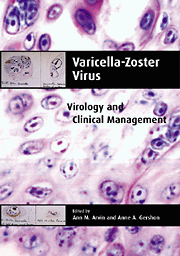Book contents
- Frontmatter
- Contents
- List of contributors
- Preface
- Introduction
- Part I History
- Part II Molecular Biology and Pathogenesis
- Part III Epidemiology and Clinical Manifestations
- Part IV Laboratory Diagnosis
- Part V Treatment and Prevention
- 18 Treatment of varicella
- 19 Treatment of herpes zoster
- 20 Management of postherpetic pain
- 21 Passive antibody prophylaxis
- 22 Development of the Oka vaccine
- 23 Primary immunization against varicella
- 24 Prevention of nosocomial transmission
- 25 Immunization against herpes zoster
- Index
- Plate section
24 - Prevention of nosocomial transmission
from Part V - Treatment and Prevention
Published online by Cambridge University Press: 02 March 2010
- Frontmatter
- Contents
- List of contributors
- Preface
- Introduction
- Part I History
- Part II Molecular Biology and Pathogenesis
- Part III Epidemiology and Clinical Manifestations
- Part IV Laboratory Diagnosis
- Part V Treatment and Prevention
- 18 Treatment of varicella
- 19 Treatment of herpes zoster
- 20 Management of postherpetic pain
- 21 Passive antibody prophylaxis
- 22 Development of the Oka vaccine
- 23 Primary immunization against varicella
- 24 Prevention of nosocomial transmission
- 25 Immunization against herpes zoster
- Index
- Plate section
Summary
Introduction
Varicella-zoster virus (VZV) is an important cause of morbidity and mortality in health care settings for both patients and health care workers especially when infection occurs in neonates, pregnant women, otherwise healthy adults, or immunocompromised persons. The Centers for Disease Control and Prevention (Williams, 1983; ACIP, 1996; Garner, 1996), the American Academy of Pediatrics (CID, 1997), the American Medical Association (AMA, 1998), and infectious disease experts (Brunell, 1982; Brawley & Wenzel, 1984; Weitekamp et al., 1985; Sayre & Lucid, 1987; Weber et al., 1988, 1996; Burns et al., 1998; Saiman et al, 1998; Stover & Bratcher, 1998; Saiman & Gershon, 1999), have published recommendations regarding the isolation of patients with VZV infection, the management of patients and health care workers exposed to VZV and immunization of susceptible health care workers with VZV vaccine in efforts to prevent nosocomial outbreaks. This chapter will focus on lessons learned from nosocomial outbreaks of VZV and provide recommendations for the pre- and post-exposure management of health care workers based on the experience at the University of North Carolina (UNC) Hospitals and the New York Presbyterian Medical Center, Columbia campus. The material contained in this chapter is adapted from recent reviews of the management of VZV in health care facilities (Weber et al., 1996; Burns et al., 1998; Saiman et al., 1998).
Patients at high risk for complications of VZV
Control of varicella is critical in health care facilities because varicella and zoster are highly contagious. Many high-risk patients develop VZV infections and require hospitalization or care in outpatient settings. Chickenpox or zoster may also develop during hospitalization for other medical conditions.
- Type
- Chapter
- Information
- Varicella-Zoster VirusVirology and Clinical Management, pp. 477 - 499Publisher: Cambridge University PressPrint publication year: 2000
- 2
- Cited by



